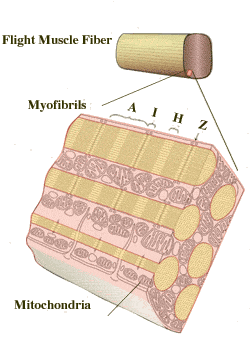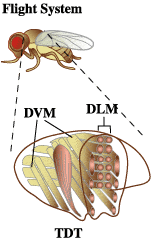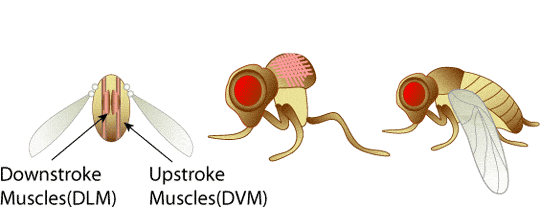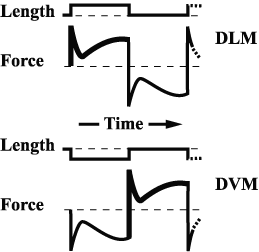
Drosophila
 Unique Muscle Structure
Unique Muscle Structure
Typically there is a trade of between muscle force and speed. Fast muscles have narrow myofibrils (that allow rapid calcium diffusion into and out of the myofibrils) along with extensive sarcoplasmic reticulum (for rapid calcium release and reuptake). Slower muscles can pack in thicker myofibrils with less sarcoplasmic reticulum at the expense of contraction speed. Insect flight muscle fibers have a unique structure that seems to break these rules. Myofibrils are cylindrical shaped with a large diameter of ~1.5 um. Within the myofibrils the characteristic banding pattern of striated muscle can be seen with sarcomeres that range from 3.0-3.4 um. Although IFM contract rapidly (~ 200 Hz), the sarcoplasmic reticulum of this muscle type is scarce. In its place are numerous mitochondria. The stretch activation response allows the high muscle contraction frequencies independent of direct nervous control.
 The Drosophila thoracic muscular system.
The Drosophila thoracic muscular system.
Wing movement in Drosophila is powered by two antagonistically oriented muscle fibers that are attached to the thoracic cuticle from which the wings extend. There are 14 dorsal ventral muscle fibers (DVM) that are located toward the outsides of the thorax. The dorsal longitudinal muscles (DLM) can be seen flanking the mid-saggital plane. The tergal depressor of trochanter (TDT), or “jump” muscle is shown lateral to the the DVMs.
Wing Movement

The wing-thorax-flight muscle system of Dipterans is capable of highly tuned resonance. It is believed that contraction of the jump muscle deforms the thoracic cuticle in such a way that causes the both the wings to move through their upstroke and to stretch the DLMs. Stretching of the DLMs activates them and their contraction deforms the cuticle the opposing way and stretches the DVMs. Stretching of the DVMs leads to their contraction which stretches the DLMs. If the timing between the delay in activation matches the characteristic frequency of the flight system a resonating oscillator will be formed.
 Stretch Activation
Stretch Activation
It is important to note that the IFM are activated by intracellular calcium via sporadic nervous stimulation. Only with this fluctuating (but sufficiently high) calcium level does the muscle contract alternately in response to a stretch produced by the other. In isolated IFM the response to stretch consists of a rapid, spring-like, increase in tension followed by a decay that is eventually overcome by a significant increase in tension (the stretch activation response). Stieger (1977) and Pringle (1978) observed that the delayed tension rise was a property of all muscles that happens to be enhanced in muscles that drive oscillating systems like cardiac and indirect flight muscle. Basically, if the delay matches the timing of the muscle extension and shortening then the muscle will perform oscillatory work and thus feed the resonating system. Several models have been proposed to explain stretch activation.